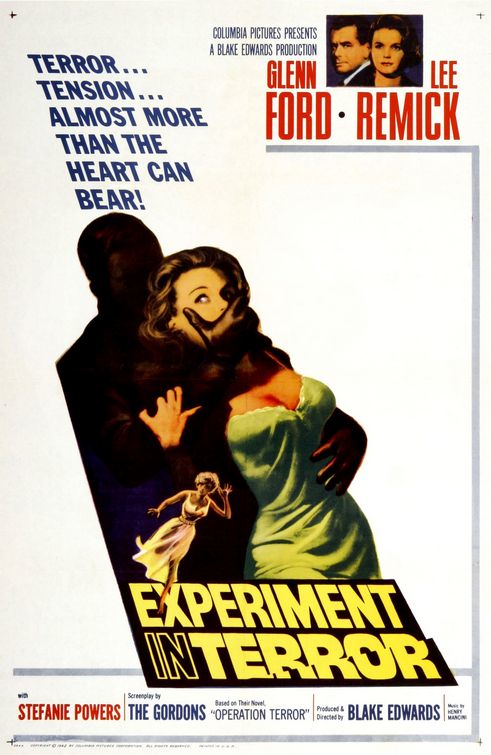 Our third classic of 2014 is a taut crime thriller from 1962 titled Experiment in Terror. It was known as The Grip of Fear in the United Kingdom, but under any title it is a beautifully written and directed suspense mystery.
Our third classic of 2014 is a taut crime thriller from 1962 titled Experiment in Terror. It was known as The Grip of Fear in the United Kingdom, but under any title it is a beautifully written and directed suspense mystery.
It was soon afterward that Blake Edwards became known for his comedic touch, what with his series of hilarious Inspector Clouseau comedies and other farces like The Great Race, The Party and, later, 10, S.O.B. and Victor Victoria. But he was just as adept at nourish mystery and suspense, having created the television series “Peter Gunn” among several other projects. I haven’t even mentioned Days of Wine and Roses or Breakfast at Tiffany’s. Edwards was a very versatile writer and director who, like Robert Wise or Howard Hawks or Michael Curtiz, could adapt himself very easily to the material at hand.
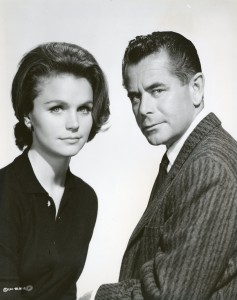
In this case the material at hand is a crime thriller involving kidnapping and robbery. A mysterious man with a breathing problem corners bank teller Kelly Sherwood (Lee Remick) in her San Francisco garage and demands that she rob her bank for him, or he will kill her — or her younger sister. He is clever and thorough; after warning her not to telephone the authorities he knocks her out when she figures she is safe and tries to call. What he doesn’t count on is that her brief conversation with the FBI is enough for them to be able to find and contact her without his knowledge. From that point on, of course, he is doomed, but there are plenty of twists and turns and hair-raising moments before justice can be served. The key to the film’s success is that those moments are delivered with style and intelligence by director Edwards working from a script by the writing couple The Gordons, who wrote the original novel “Operation Terror,” upon which the movie is based. Their script is brimming with detail that keeps the story moving yet fully delineates the various characters and their emotional states. Edwards does his part to contribute interesting visual compositions and proper pacing, and Henry Mancini goes above and beyond his assignment with an iconic music theme and score that is instantly recognizable and incredibly evocative.
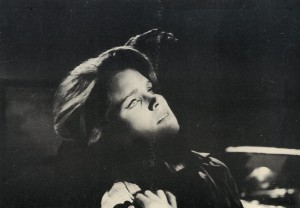
I’ll talk about the music here since it is so memorably distinctive. Henry Mancini’s slow bass and guitar theme plays through the opening credits, then appears here and there in the movie. It instantly sets the mood of doom, yet is absolutely compelling to hear. I think it is one of Mancini’s greatest themes. I first heard it as a youth in Chicagoland because WGN used that theme for its Friday evening fright flick show, “Creature Features.” I have since learned that other television stations around the country had their own similar shows, and some of them also used this diabolical Mancini music. I didn’t see Experiment in Terror until much later, and when I did I instantly sat up when I recognized the first strains of the theme. Once you hear it the music simply cannot be forgotten. It deepens the mood of the film without ever overwhelming the suspense; it’s a terrific score.
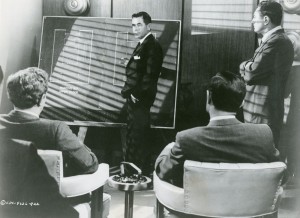
Like The Naked City before it, much of this movie’s drama depends upon police procedure and protocol. The plot is a jigsaw puzzle of evil intent, convincing menace, lots of leg work, a clever plan, unexpected tangents, crowded areas, persons of interest who will not talk, surveillance, fog, and, of course, luck. From the very beginning the FBI takes the threat seriously, and very quickly the plan and the target location are known. But that is only part of the equation; agent John Ripley (Glenn Ford) and his team do not know the identity of the perp, the timing of the intended crime, or the delivery method. They set out to learn his identity, and for me this is the most interesting part of the movie because two other separate subplots eventually link the mysterious man with the breathing problem to the threatened bank robbery.
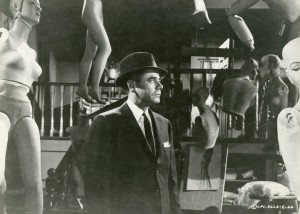
One lead — which could only occur in the movies — takes place when Nancy Ashton (Patricia Huston) calls the FBI and happens to talk to agent Ripley. We sense immediately that she is connected to the situation in some way, but Ripley does not. He provides advice for her “friend,” and sends her on her way. Ripley is surprised to hear from her again, when she asks him to visit soon, as she is in trouble. The creepiest scene in the movie follows, before Ripley can get there. When he and a partner arrive they find a place right out of a horror movie, what with mannequins, whole and in pieces, all over her apartment (she evidently puts them together and paints them for stores). Of course they find more than just mannequins, along with a piece of evidence that definitely links Nancy Ashton to the mysterious man. This sequence works so well because of the eerie visual elements — the dismembered mannequins all over the place on two different levels and even hanging from the ceiling — the quietness of the scene and the relentless sense of impending doom. It also works because it shows how just a slight change in timing or emphasis on speed by the police could have made a huge difference in someone’s life.
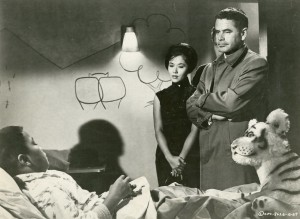
The other subplot explores the idea that even the worst criminals have redeeming sides. Clues link Lisa Soong (Anita Loo) to the asthmatic man, but she refuses to help the authorities in any way. Her son Joey (Warren Hsieh) provides the answer to their relationship, one which confounds Ripley and the FBI but makes perfect sense to anyone who owes a debt of gratitude — or financial relief — to another person, no matter what their background. This subplot adds dimension to the mystery, as well as providing what amounts to a red herring connection. It also reinforces the timing emphasis, because the story could have altered quite a bit had agent Ripley made his initial visit a few minutes earlier or later. This subplot humanizes the mysterious asthmatic man by offering a glimpse into his life.
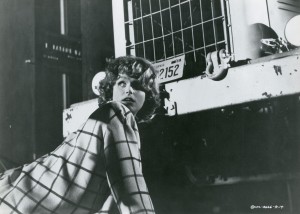
But the focus throughout the story is squarely on pretty bank teller Kelly Sherwood. Frightened at her own home, Kelly is smart enough to keep her contact with the FBI out of sight of the madman. Yet as agent Ripley correctly predicts, she gradually becomes unglued as the ordeal intensifies. One contact meeting nearly ends in disaster, as seen in the photo at left. It’s interesting that the patterns on her coat and the truck’s front grill reinforce Edwards’ established visual motif of vertical and horizontal intersecting lines; patterns like these are evident in many scenes and have a significance that I can recognize but do not fully understand. Edwards and cinematographer Philip Lathrop have filled the film with crosscut shadows, dark vertical lines and black spaces that invite terrors from the imagination. Another trick employed is a sort of visual vertigo in certain scenes involving Kelly, in which she is seen from above or below as her level of fright increases. The camerawork in this movie is often masterful, reminding me of top-flight Hitchcock.
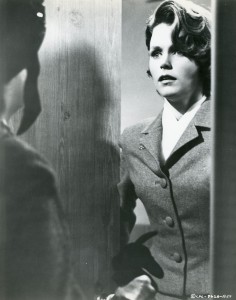
Kelly Sherwood is portrayed by Lee Remick, an actress who was quite popular in the late 1950s and early 1960s, from A Face in the Crowd and Anatomy of a Murder through her Oscar-nominated performance in Edwards’ Days of Wine and Roses. She never became a major star but she was fun to watch in a lot of movies, such as Hard Contract and Telefon. Remick is solid here, especially repressing the emotional turmoil that Kelly must feel, yet she never really gets the opportunity to let loose and lose control. Remick is at her best when she’s really on edge, such as the scene in the ladies’ room, or when she goes through with the robbery.
Glenn Ford was no stranger to the role of authority, having played a tough detective in The Big Heat almost a decade earlier. Ford is the voice of reason and the symbol of competence of the FBI, and he’s fine. It would have been nice, however, if Ripley, too, could have been allowed to lose his temper once in a while when things go wrong, and especially when innocent people are hurt. Ripley expresses frustration, but I wanted to see him get upset as the madman thwarts him again and again.
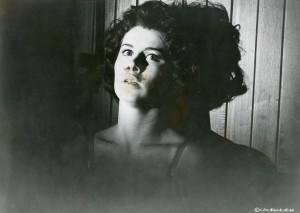
The third major cast member is Stefanie Powers, playing Kelly’s younger sister Toby. She is supposed to be a teenager, yet definitely seems older (Powers was 20 when the movie was released). Although Kelly is the madman’s target, it is Toby who must endure the most explicit humiliation and fear at his hands. Compared to today the film is quite tame, but Toby’s situation late in the movie was risqué in 1962, and remains quite effective today. Part of its effectiveness is due to the setting, a dusty warehouse room, spare and bare, in the middle of bustling San Francisco and yet as remote from help as can be. Adding to the creepiness is the asthmatic man’s obvious sexual interest in Toby and her disgust at his touch. Nowadays a sequence such as this would be far more explicit and vile, but Edwards couldn’t go very far in that direction, nor do I believe he really wanted to.
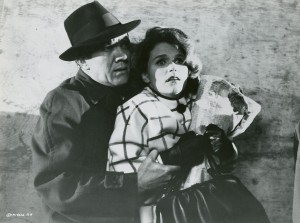
The asthmatic breather with robbery on his mind is seen only at oblique angles early in the film, but is soon revealed to be portrayed by Ross Martin. The actor received special billing at the end of the film, before the final fadeout. It is a chilling performance, cold and calculated and full of menace. One disguise in particular is startling and amusing, but that is the only light-hearted aspect of his role. Although he isn’t seen to advantage, often being in shadow, disguise, in sunglasses or hiding, Martin just about steals the show as the breath-challenged bank robber. He nabbed a Golden Globe nomination for the role. This was one of many jobs that Ross Martin did for Blake Edwards, who used him on television (he played Andamo on “Mr. Lucky”) and in the movies (The Great Race). Best known for “The Wild, Wild West” series, Martin was a capable actor who didn’t seem to mind subjugating his own stardom for the sake of a good role.
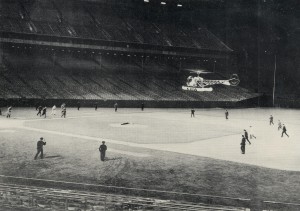
On top of everything else, this is a baseball movie! The concluding act takes place at Candlestick Park, with the Giants hosting the Los Angeles Dodgers. Several players are seen in close-up, including L. A. pitcher Don Drysdale and catcher John Roseboro, although if you watch carefully when a double play is hit into, the batter is #12 and the runner thrown out at first is #55! The date of the game shown is August 18, 1961 and the Giants won, with a final score of 2 to 1. Other trivia from the film includes a “Twin Peaks” road sign (an influence for David Lynch?) and a fisherman’s wharf place called “Tarantino’s”. Astute viewers have also noted that Kelly is tasked to steal $100,000, but there is little chance that she could walk out of the bank with that much money in her little purse.
Speaking of money, I have no idea how well Experiment in Terror made out at the box office. It received strong reviews, but I cannot easily find any revenue data for it. 1962 was a great year for movies, both domestic and of foreign origin, and it would have faced excellent competition. Nevertheless, I have to assume that it did fairly well.
Is Experiment in Terror a classic? Yes. A minor classic perhaps, partly because it is not groundbreaking in any way, but it is superbly staged, scored and photographed. What could have been a routine crime thriller is immeasurably boosted by solid performances, excellent writing and cinematography. I probably enjoy thrillers and suspense stories more than any other kind of movie (because thrills and suspense cross genres and can enliven all kinds of movies), and I’ve always thought very highly of this movie. It’s a little dated and a little more subdued than it ought to be, but it’s really good. My rating: ☆ ☆ ☆ 1/2. 26 January 2014.
